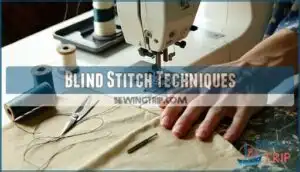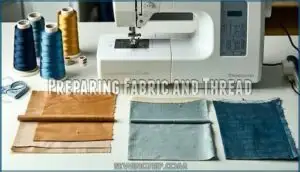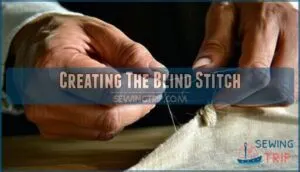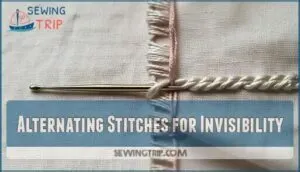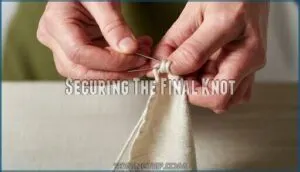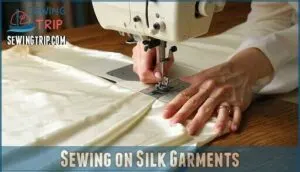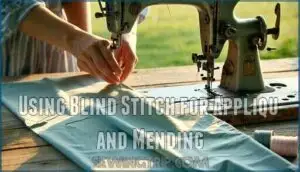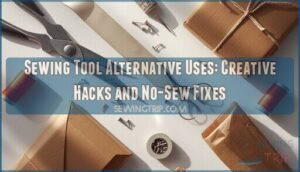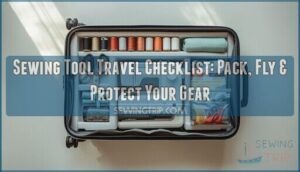This site is supported by our readers. We may earn a commission, at no cost to you, if you purchase through links.
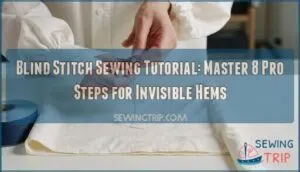 A blind stitch sewing tutorial teaches you to create invisible hems that look professionally finished.
A blind stitch sewing tutorial teaches you to create invisible hems that look professionally finished.
You’ll fold your fabric, catch tiny threads from the garment’s front while securing the hem underneath.
This technique works perfectly for pants, curtains, and dress hems where visible stitching would ruin the look.
The key is using matching thread and taking minimal fabric with each stitch.
Your needle barely grazes the front fabric, making the hem disappear completely.
Most sewers struggle with tension control and thread visibility at first.
Once you master the rhythm of alternating between hem and garment, you’ll wonder why you ever used visible stitching.
The secret lies in understanding exactly how much fabric to catch.
Table Of Contents
- Key Takeaways
- Blind Stitch Basics
- Blind Stitch Techniques
- Top 8 Blind Stitch Tools
- 1. Sewing Thread Kit with Case
- 2. Polyester Sewing Thread Assortment Kit
- 3. Polyester Sewing Thread Set Assortment
- 4. assorted hand sewing needles set
- 5. Singer assorted hand sewing needles
- 6. Sharps hand sewing needles size
- 7. Ultra Lightweight Fusible Interfacing Fabric
- 8. White fusible interfacing fabric sheets
- Blind Stitch Step Guide
- Specialized Blind Stitch Applications
- Mastering Blind Stitch Sewing
- Frequently Asked Questions (FAQs)
- Conclusion
Key Takeaways
- Perfect your thread selection – You will achieve invisible results by matching the thread color exactly to your fabric or choosing one shade darker, using polyester or silk thread for durability.
- Master the stitch technique – You will create truly invisible hems by catching only 1-2 threads from the main fabric and alternating between tiny stitches on the garment and longer ones on the hem fold.
- Control your tension and spacing – You will prevent puckering and visible stitches by keeping the thread tension loose but secure and spacing stitches 1/4 to 1/2 inch apart consistently.
- Choose the right tools – You will get professional results by using sharp, thin needles (size 9-11 for lightweight fabrics) and practicing on scraps before working on your actual garment.
Blind Stitch Basics
You’ll discover blind stitch as the secret weapon for creating perfectly invisible hems that look professionally finished.
This hand-sewing technique connects fabric edges without showing any stitches on the right side of your garment.
Definition and Purpose
A blind stitch creates invisible connections between fabric pieces without visible stitches on the right side.
You’ll use this fundamental technique for hemming garments, appliqué work, and mending projects.
Master the magic of invisible hems with blind stitch – your secret to professional-looking garments.
The stitch catches only a few threads of the outer fabric, making repairs nearly undetectable, and gives you professional-quality results for any sewing project.
Mastering the blind hem stitch technique is essential for achieving flawless hems.
Hand Sewing Vs Machine Sewing
Your choice between hand sewing and machine sewing affects stitch speed, sewing accuracy, and fabric handling.
Hand sewing offers superior control for delicate fabrics but requires patience. Machine sewing provides efficiency but may compromise thread tension precision.
Consider these factors:
- Hand sewing: Perfect thread tension control, ideal for silk and lightweight fabrics
- Machine sewing: Fast sewing efficiency, consistent stitch guide results
- Fabric handling: Hand method protects delicate materials better
Ideal Projects for Blind Stitch
You’ll discover blind stitch sewing shines in specific projects where invisible seams matter most.
Perfect for garment repair and fabric mending, this technique transforms curtain hemming into professional-looking results.
Home decor projects benefit from clean finishes, while toy making requires durable invisible stitches.
Blind hem stitch creates flawless hems on pants, skirts, and dresses for polished appearances.
Blind Stitch Techniques
You’ll master professional blind stitch techniques by focusing on three key elements: thread selection, needle choice, and stitch execution.
These fundamental skills will transform your hemming from amateur to expert level with practice.
Thread Selection and Color Matching
Perfect thread selection reveals invisible blind stitch sewing success.
Master your invisible hems with the right thread—it’s the difference between amateur and professional results.
Match thread colors precisely to your fabric’s dominant shade, choosing slightly darker when uncertain.
Test different thread types and dye lots on fabric scraps before committing.
- Silk threads glide through delicate fabrics like butter, creating seamless invisible stitches
- Polyester threads withstand countless washes while maintaining perfect color integrity
- Gray thread becomes your secret weapon for blending with most fabric colors
- Monofilament threads disappear completely on patterned or multi-colored materials
- Color theory transforms amateur attempts into professional-quality blind stitch sewing results
For achieving professional-looking hems, understanding the best thread size options is vital to attain professional-looking hems.
Needle Selection and Thimble Use
Your needle’s eye determines thread compatibility and fabric penetration.
Select sharp, thin needles with small eyes for delicate fabrics.
Use size 9-11 for lightweight materials, 12-14 for medium weights.
A thimble protects your finger from needle pricks during repetitive blind hem stitch work.
For best results, choosing the right sewing needles is vital for various fabric types.
| Needle Sizes | Fabric Weight | Thimble Materials | Hand Protection |
|---|---|---|---|
| 9-11 | Lightweight silk, chiffon | Metal | Prevents finger soreness |
| 12-14 | Cotton, linen blends | Leather | Reduces needle slippage |
| 16-18 | Heavy denim, canvas | Plastic | Comfortable for beginners |
| Ball point | Knits, stretch fabrics | Silicone | Flexible finger movement |
The correct selection of needles and thimble materials can significantly impact the quality of your work, providing hand protection and preventing accidents.
This is crucial for achieving professional results, especially when working with delicate fabrics or performing intricate stitches.
Stitch Execution and Tension Control
Perfect stitch tension transforms your blind hem stitch from amateur to professional.
Set your tension between 2-3 for most fabrics, reducing further for knits to prevent puckering. Control your needle angle and stitch length while maintaining gentle thread control.
Catch only 1-2 threads of the outer fabric, spacing stitches evenly. This invisible stitch technique creates flawless ladder stitch results without fabric stretch.
Achieving the right thread tension is essential for preventing issues with thread flow problems, and it helps to create a professional finish by using the blind hem stitch and maintaining gentle thread control.
Top 8 Blind Stitch Tools
You’ll need the right tools to create professional-looking blind stitches that truly disappear into your fabric.
Having quality thread, sharp needles, and proper interfacing makes the difference between amateur-looking hems and the polished finish you see on high-end garments.
1. Sewing Thread Kit with Case

When you’re ready to tackle blind stitch sewing, a thorough sewing thread kit with case becomes your best friend.
These kits typically contain 27 to 96 spools in vibrant colors, giving you the thread variety needed for perfect color matching.
You’ll find polyester threads that resist fraying and breaking, plus essential tools like needles, scissors, and a seam ripper.
The portable case keeps everything organized with elastic straps and compartments, making it perfect for travel repairs and home projects alike.
Best For: Sewing enthusiasts, travelers, and crafters who need a comprehensive thread collection with matching colors for various projects including blind stitch sewing, embroidery, and general repairs.
- Wide color variety (36 vibrant colors) with matching prewound bobbins saves time and ensures perfect color coordination
- High-quality polyester thread resists fraying and breaking, providing durability for both hand and machine sewing
- Organized portable case with compartments keeps everything accessible for home projects and travel repairs
- Thread may break on high-speed sewing machines like Singer Futura, requiring careful machine setup and slower speeds
- Lightweight bobbin case may feel less premium compared to heavier alternatives
- Thread ends can be difficult to locate initially, requiring tools like pins to find them
2. Polyester Sewing Thread Assortment Kit
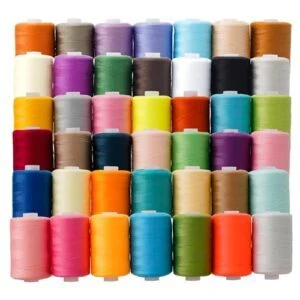
A rainbow of colors awaits you in these extensive polyester thread assortment kits.
You’ll find 30 to 100 spools with 250 to 400 yards each, covering vibrant and neutral tones for perfect color matching.
The 100% polyester construction resists breakage and fading while maintaining flexibility for seams that move with your garments.
These kits work beautifully for hand and machine sewing, making them ideal for blind stitch projects where thread strength and color precision matter most.
Best For: Sewers and crafters who need a comprehensive thread collection for multiple projects, from garment construction to quilting and embroidery work.
- Some users report occasional thread breakage issues despite overall durability claims
- Large kits may include colors that go unused for specific projects, potentially reducing individual value
- Storage and organization of numerous spools can become cumbersome without proper thread management systems
- Extensive color variety with 30-100 spools offering 250-400 yards each, providing excellent value and long-term supply
- High-quality 100% polyester construction resists breakage, fading, and maintains flexibility for durable seams
- Versatile compatibility with both hand and machine sewing across various fabric types
3. Polyester Sewing Thread Set Assortment
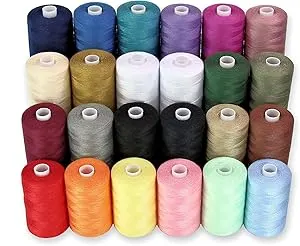
This thread treasure-trove offers 24,000 yards of premium polyester thread across 22 colors plus black and white spools.
You’ll get consistent performance with 40/2 spun polyester that won’t break during delicate blind stitch work.
The azo-free dyes guarantee your invisible hems stay color-fast through countless washes.
Each 1,000-yard spool provides enough thread for multiple garment projects, making this set perfect for extensive hemming work or teaching others your newfound blind stitch skills.
Best For: Sewers who need a reliable, large-quantity thread collection for extensive projects like quilting, garment construction, or teaching classes.
- May experience thread breakage and splitting issues with certain fabric types like knits and delicate materials
- Limited to 22 colors plus black and white, which may not meet all color-matching needs
- Performance can vary with different machine tensions and may require adjustment for optimal results
- Exceptional value with 24,000 total yards across 24 spools for extensive sewing projects
- Azo-free dyes ensure excellent colorfastness that won’t fade through repeated washing
- Versatile 40/2 spun polyester works well with both hand and machine sewing on various fabric types
4. assorted hand sewing needles set
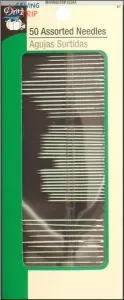
Why settle for basic needles when you can achieve professional results?
The Dritz Hand Needles assorted set delivers 50 precision-crafted needles in seven essential types.
You’ll get Betweens for quilting, Sharps for general sewing, and specialized Tapestry needles for delicate blind stitching.
These nickel-plated steel needles resist rust and glide smoothly through fabric.
The variety guarantees you’ll always have the right tool for invisible hems on any material.
Best For: Sewists, quilters, and crafters who need a comprehensive needle collection for various hand sewing projects from delicate embroidery to heavy-duty repairs.
- Complete variety with 50 needles across 7 essential types (Betweens, Sharps, Darners, Tapestry, Crewel) for any sewing task
- Nickel-plated steel construction provides durability, rust resistance, and smooth fabric penetration
- Economical value with decades worth of needles in assorted sizes from fine detail work to heavy fabrics
- Some users report inconsistent sharpness quality with certain needles arriving dull
- Limited return options for international customers based on user feedback
- May include more specialty needles than casual sewers actually need for basic projects
5. Singer assorted hand sewing needles
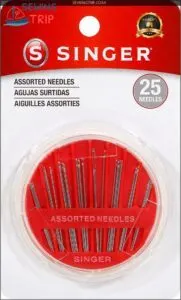
Choose Singer’s assorted hand sewing needle set for your blind stitch arsenal.
This 25-piece collection delivers betweens, darners, sharps, and embroidery needles in one compact case.
You’ll match the right needle to your fabric weight every time.
The nickel-plated steel construction resists rust and stays sharp through countless hems.
Singer’s century-old reputation speaks volumes about durability.
The dial-a-needle compact keeps everything organized and prevents those frustrating needle hunts mid-project, making it a great addition to your sewing kit with its nickel-plated steel construction.
Best For: Sewists and crafters who need a versatile needle collection for various projects including mending, hemming, embroidery, and general sewing tasks.
- Some users report perceived decline in needle strength compared to older versions
- Very fine needles may break when used on tougher materials beyond their intended weight
- Missing needle threader tool noted as a drawback by some users
- Complete variety of needle types (betweens, darners, sharps, embroidery) in one organized compact case
- Nickel-plated steel construction resists rust and maintains sharpness through heavy use
- Dial-a-needle storage system keeps needles secure and easily accessible during projects
6. Sharps hand sewing needles size
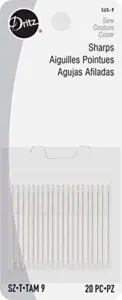
Size 9 Sharps needles pack just the right punch for blind stitch projects.
You’ll find these medium-length needles hit the sweet spot between sizes 5-10, perfect for light to medium fabrics.
Their sharp points and round eyes make threading easier while maintaining strength.
The fine diameter minimizes visible holes in your fabric, keeping your invisible stitches truly invisible.
Though some sewers find the eyes tiny, experienced crafters love their precision for detailed hemming work.
Best For: Experienced sewers working on blind stitch projects, detailed hemming, and light to medium fabric work where precision and invisible stitches matter most.
- Sharp points and round eyes provide excellent precision for detailed work while maintaining needle strength
- Fine diameter creates minimal visible holes, making them ideal for invisible stitching and blind hems
- Perfect size range (5-10) for light to medium fabrics with good balance of strength and finesse
- Small eye size can be challenging to thread, especially for those with vision or dexterity issues
- Thin metal construction may bend under heavy use or with thick fabrics
- Shorter length compared to other needle types may be difficult for some users to handle comfortably
7. Ultra Lightweight Fusible Interfacing Fabric
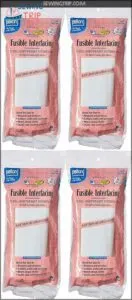
Stability becomes your secret weapon when ultra lightweight fusible interfacing joins your blind stitch toolkit.
This 100% polyester miracle worker weighs just 25 grams per square meter, adding structure without bulk.
You’ll love how it prevents fabric stretching during delicate blind stitch work, and it’s perfect for collars, cuffs, and facings where invisible support matters most.
Simply press it onto your fabric’s wrong side with steam for 10-15 seconds, and it bonds permanently while keeping your project’s natural drape intact.
Best For: Sewers working on delicate fabrics like linen, jersey, and chambray who need invisible support without adding bulk to their projects.
- Ultra lightweight at just 25 GSM, providing structure while maintaining natural fabric drape and softness
- Heat-activated permanent bond that prevents fabric stretching and distortion during sewing
- No pre-shrinking required and compatible with machine washing and dry cleaning for long-lasting results
- Actual width may be slightly less than advertised (14-3/4" vs 15" reported by some users)
- Not suitable for heat-sensitive fabrics like triacetate, lace, or rainwear materials
- Requires steam iron and proper pressing technique to achieve optimal adhesion without bubbling
8. White fusible interfacing fabric sheets
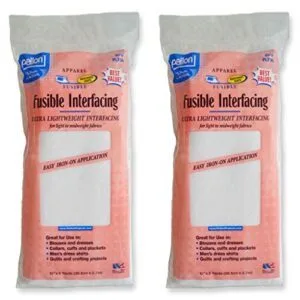
White fusible interfacing fabric sheets transform your blind stitch projects by adding professional structure and stability.
These 100% polyester sheets feature heat-activated adhesive that bonds permanently to fabric when you press with a hot iron.
You’ll find them perfect for reinforcing collars, cuffs, and buttonholes before blind stitching. The white color prevents show-through on light fabrics.
Simply trim to your pattern, position adhesive-side down, and press with a cloth barrier to prevent sticking, ensuring a professional finish.
Best For: Sewers and crafters working on garments or projects requiring professional structure and stability, particularly those using light-colored fabrics where show-through is a concern.
- Heat-activated adhesive creates permanent bonds without need for basting or pinning, streamlining construction
- 100% polyester material provides excellent durability and maintains integrity through multiple washes
- White color prevents visible darkening on light fabrics while adding professional structure to collars, cuffs, and buttonholes
- High heat application may damage delicate or heat-sensitive fabrics during the fusing process
- Incorrect weight selection can make garments feel overly stiff and lose their natural drape
- Requires careful matching of interfacing type to fabric weight for optimal results and garment longevity
Blind Stitch Step Guide
You’re ready to master the blind stitch technique that creates perfectly invisible hems on any garment.
Follow these eight clear steps to achieve professional results that’ll make your sewing look store-bought.
Preparing Fabric and Thread
Begin by selecting quality materials for your blind hem stitch project.
Thread Matching requires choosing thread that perfectly matches your fabric’s color or goes one shade darker.
Material Quality matters – use strong polyester or cotton thread to prevent breakage.
Fabric Preparation involves pressing and folding hem edges cleanly.
Test your Color Choices and Thread Matching on fabric scraps first.
For the best results, consider using a sewing thread kit to guarantee the best thread quality.
This will help ensure a strong polyester or cotton thread is used, which is crucial for preventing breakage and achieving a professional finish with Thread Matching.
Creating The Blind Stitch
Position your needle at the hem’s edge and catch only two threads of the main fabric. This creates the foundation for your invisible stitch technique.
- Stitch Tension: Keep thread loose enough to prevent puckering but tight enough for security
- Needle Size: Use a sharp, thin needle that won’t leave visible holes in delicate fabrics
- Sewing Speed: Work slowly and deliberately to maintain consistent thread color matching throughout
Alternating Stitches for Invisibility
Each invisible stitch creates a hidden bridge between your hem and garment.
Catch only 1-2 threads from the main fabric, then move to the folded edge for a longer stitch.
This alternating pattern forms concealed stitches that disappear when pulled taut.
Space stitches 1/8 to 3/8 inch apart for perfect invisible hems without puckering or visible thread.
Securing The Final Knot
After completing your alternating stitches, you’ll need to lock everything in place with proper knot tying. This final step prevents your hard work from unraveling and gives your invisible stitch professional durability.
Your sewing completion depends on securing the thread correctly while maintaining fabric tension throughout the process.
- Create a small knot close to the fabric surface – Keep it tight against the hem fold
- Pull the thread through existing stitches – This hides the knot inside the fabric layers
- Trim excess thread about one inch from the fabric – Leave enough to prevent fraying
- Check stitch reinforcement by gently tugging the seam – Confirm everything holds firmly
- Inspect the hem from the right side – Confirm no thread trimming marks show through
Mastering the invisible stitch technique is vital for achieving professional-looking hems.
Specialized Blind Stitch Applications
You’ll expand your blind stitch skills when you work with different fabrics and special sewing projects.
These techniques help you create professional results on silk garments, pants hems, and repair work that needs to stay invisible.
Sewing on Silk Garments
Silk fabric demands extra care when blind stitching due to its delicate nature.
Use silk thread or monofilament for invisible results. Choose microtex needles in sizes 60/8 for lightweight silk or 70/10 for medium-weight varieties.
Catch only 1-2 threads per stitch to prevent puckering. Keep tension light and use 3mm stitch length.
Practice on scraps first to perfect your technique.
Hemming Pants and Other Garments
Hemming pants transforms your wardrobe with professional results.
Master these garment fitting essentials through proper fabric folding and seam allowance management:
- Measure twice – Mark your desired hem length with pins before cutting
- Fold cleanly – Create crisp creases using proper hemming techniques for consistent stitch length
- Test first – Practice your blind stitch on fabric scraps to perfect stitch patterns
Your sewing tutorials just got easier with these proven hemming methods.
Using Blind Stitch for Appliqué and Mending
Beyond garment hemming, blind stitch excels in appliqué work and fabric repair. You’ll find this technique invaluable for attaching decorative elements without visible stitches showing through.
The blind stitch creates seamless repairs that blend naturally with your fabric’s texture. Mastering invisible mending techniques is essential for achieving professional-looking results in various sewing applications.
| Application | Blind Stitch Benefit |
|---|---|
| Appliqué Attachment | Invisible edges on decorative pieces |
| Tear Mending | Seamless fabric repair without bulk |
| Patch Application | Hidden stitch lines for clean finish |
| Trim Attachment | Secure decorative elements invisibly |
These sewing tricks transform visible repairs into professional-looking fixes that won’t betray your mending work.
Mastering Blind Stitch Sewing
Perfect blind stitch technique comes with practice and the right approach to common challenges.
You’ll master this invisible hem method by focusing on consistent spacing, proper tension, and using simple tools to keep your stitches straight, which will help you achieve perfect blind stitch technique.
Practice and Patience for Mastery
Stitch Mastery requires dedicated practice on scrap fabric before attempting actual projects.
Your sewing skills improve through repetition and Patient Approach.
Start with simple hems using basic sewing techniques.
Master these sewing basics through consistent Practice Techniques.
Remember that blind stitch perfection doesn’t happen overnight.
Each sewing tutorial session builds muscle memory.
Focus on Mastery Tips like maintaining even tension and consistent spacing.
Your sewing stitches will naturally become invisible with time, and this is the key to achieving Stitch Mastery.
Troubleshooting Common Mistakes
When trouble strikes your blind stitch sewing tutorial, focus on these key fixes.
Thread breakage often stems from poor needle selection or excessive tension issues. Stitch visibility happens when you catch too much fabric or use mismatched thread colors.
Fabric puckering indicates tight tension settings that need adjustment.
Practice proper sewing techniques and follow clear sewing instructions to master invisible stitch sewing.
Tips for Even Spacing and Minimal Visibility
Achieving razor-sharp spacing between stitches transforms your blind stitch from amateur to professional.
Space stitches 1/4 to 1/2 inch apart for ideal invisibility. Match your thread color perfectly—even slight mismatches scream "homemade."
Keep stitch tension loose but secure. Catch only one or two fabric threads per bite. Practice your rhythm on scraps first.
Consistent spacing creates flawless invisible hems every time.
Using Marking Tools for Straight Lines
When hemming garments, marking tools transform guesswork into precision.
You’ll achieve professional results by using sewing aids that create straight edges and consistent measurements.
- Tailor’s chalk marks temporary lines that brush away cleanly after stitching
- Fabric guides help maintain even spacing between blind stitch placements
- Measuring techniques guarantee uniform hem depths across entire garment edges
- Sewing aids like rulers create perfect straight lines for professional finishes
- Stitch tutorial accuracy improves when you mark reference points first
Using proper tailors chalk tools(tailors chalk) is essential for achieving accurate markings.
Frequently Asked Questions (FAQs)
Can you sew a blind stitch by hand?
Yes, you can absolutely sew a blind stitch by hand.
Thread your needle with matching thread, hide the knot in the fabric fold, then alternate tiny stitches between the main fabric and hem edge for an invisible finish.
What is a blind stitch in sewing?
Like a magician’s vanishing act, a blind stitch creates invisible seams that disappear into your fabric.
You’ll catch only a few threads of the outer material while alternating between tiny stitches on the main fabric and longer ones on the hem fold.
How do you blind stitch fabric?
Thread your needle and tie a knot. Hide the knot inside the fabric fold.
Take tiny horizontal stitches through the main fabric, catching only a few threads. Alternate with longer stitches along the folded hem edge, spacing them evenly apart, to ensure a secure finish.
How do I perform a blind stitch?
Rome wasn’t built in a day, and neither is perfect blind stitching.
Hide your knot inside the hem fold.
Take tiny horizontal stitches through the main fabric, catching only a few threads. Alternate with longer stitches along the folded edge, keeping even spacing throughout.
How do you make a blind hem stitch?
Fold your fabric hem twice, then catch just a few threads of the main fabric with tiny horizontal stitches.
Alternate between small stitches on the main fabric and longer stitches through the folded hem edge, this process involves tiny horizontal stitches.
Do all sewing machines have a blind hem stitch?
No, not all sewing machines have a blind hem stitch.
Basic models often skip this feature while mid-range and higher-end machines typically include it.
Check your machine’s manual or stitch selection dial to see if you’ve got this handy function available.
What is the purpose of blind stitching?
You’ll create invisible seams that hide stitches from the right side of fabric. This technique gives you professional-looking hems on pants, skirts, and curtains without visible thread lines showing through.
What happens if blind stitch thread breaks?
Your seemingly perfect invisible hem suddenly becomes visible everywhere.
You’ll need to restart that section completely.
Use quality thread that matches your fabric.
Test thread strength first.
Secure knots properly inside fabric folds.
Can blind stitch work on stretch fabrics?
Yes, you can use blind stitch on stretch fabrics, but you’ll need a ballpoint needle to prevent snags.
The technique works best when you don’t pull the thread too tight, allowing the fabric to maintain its natural stretch and movement.
How do you remove blind stitches later?
Oh, the irony of wanting to undo your "invisible" masterpiece.
Carefully cut the thread between stitches using small scissors or a seam ripper.
Pull gently to remove thread pieces without damaging the fabric.
Conclusion
Professional sewers know that invisible hems separate amateur work from expert craftsmanship.
You’ve now learned the essential techniques for creating flawless blind stitches that disappear completely.
This blind stitch sewing tutorial gives you the foundation to tackle any hemming project with confidence.
Remember to match your thread perfectly and catch minimal fabric with each stitch.
Practice these eight steps on scrap fabric first.
Your patience will pay off when friends ask where you’d your hems professionally done.
- https://www.applegreencottage.com/invisible-stitch-ladder-stitch/
- https://help.singer.com/en-US/how-to-blind-hem-410010
- https://makeit-loveit.com/blind-invisible-hem-stitch-sewing-machine
- https://www.youtube.com/watch?v=pbiQt9RJg2Q
- https://www.wawak.com/sewing/sewing-needles-by-type/blind-stitch-needles/

